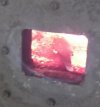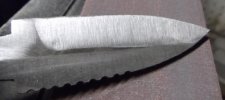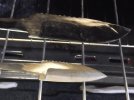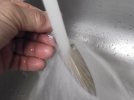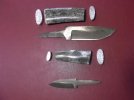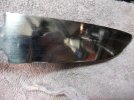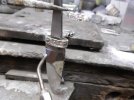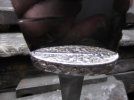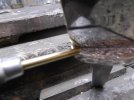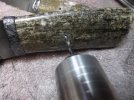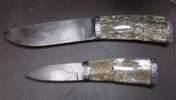Justin - Yes, when we were done talking I picked it up and dropped it in my bag. It came out Monday morning and this project started.
Rapture - The solder used for joining/sealing guards and bolsters is also called "silver solder", but that is a misleading name. It is a low temperature "silver bearing solder". It melts at 400° or lower, and makes a good seal. Popular brands are Stay-Brite and TIX. They require a matching flux to the brand of solder. Their use is covered in detail in many threads and tutorials. Use this search engine to find all sorts of threads on any subject:
https://www.google.com/cse/home?cx=011197018607028182644:qfobr3dlcra
For example:
http://www.bladeforums.com/forums/showthread.php/713723-Is-Stay-Bright-Silver-Solder-any-good
Here are a few comments I made on one of those threads:
The big tips are:
Before you start to do a solder joint the metal needs to be sanded/filed to a bright and smooth surface. Wash the blade and guard with soap and water, and then clean with denatured alcohol.
1) Use very little heat ( a torch can be several thousand degrees, but you only need to heat the blade/guard to 400F).Don't heat the joint, but heat the blade at the ricasso and bottom of the guard. Apply the flux and solder from the tang side ( opposite the heat source). Properly heated, there is no risk to the temper of the blade.
Too much heat will burn the solder. If it turns black, shut off the torch...take everything apart, clean it up, and start over.
2) Use very little solder. The best way to avoid having to clean up a solder mess is to not have the mess at all. Pounding the solder flat into thin ribbons is a good way to use less. Cut tiny snippets from this ribbon. Apply four snippets to start with, and add more as needed when it starts to flow.
3) Make everything fit snug. The guard should be a tight fit to the blade. The perfect situation is to have to tap the guard down the last 1/4" or so. Solder will flow through a tight joint perfectly. If there is a gap, the solder will most likely not cover it.
4) The solder is not a structural ingredient. It is a sealant and cosmetic item. The joint should be firm and not wiggly. Don't expect solder to compensate for sloppy guard fitting.
5) Clean up the joint after the solder is cooled. First, wash off the excess flux. Then ,using a clean up tool, cut the excess solder away from the joint. Make the tool like a tiny chisel ( flat graver) and make it from brass or bronze. Don't use a hardened tool, like a real chisel, or it may scratch the blade or guard.

